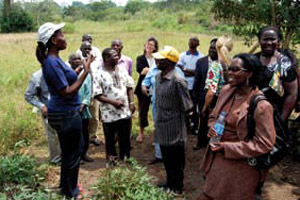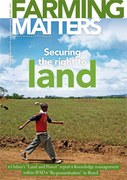Over the past year ILEIA has contributed to the knowledge management activities of IFAD’s East and Southern Africa Division by facilitating a documentation process in Uganda. This involved representatives of four different projects, all of them interested in drawing out specific lessons from their work. In the words of Carole Idriss-Kanago, the Associate Country Programme Manager, this process has helped participants to “identify those points which make us special and value the importance of sharing them with others”.

We started with a four-day workshop that took place in Kampala in January, where we first went through the basic concepts, principles and conditions needed for a successful documentation process.
We stressed the difference between a documentation process and a description, the need to include different opinions and, most importantly, the role of documentation in “generating knowledge”.
After a short presentation of the methodology, we immediately started the documentation process with the aim of “learning by doing”. This meant selecting the part of the project that participants wanted to document and share, describing the main activities and results, and analysing them all in detail, selecting indicators for the results and impact of the project and identifying the reasons (or causes) behind each one.
The four different teams then continued with the description and analysis of their work at their own project bases, identifying the main issues that confronted them while going through the process: the importance of “narrowing” or further defining the case to be documented; the analysis, considering the identification and use of criteria and indicators; the need to capture additional information; and the general presentation of the results. Meetings were then held separately with each team.
Learning by doing
After going through the complete process, participants realised that, in contrast to what they had thought at the beginning, documenting one’s own experience is not necessarily difficult, or something that has to be done by external consultants. Participants found that the process “helped us find a way to tell the untold story”. They also identified some key issues that need special attention.
- Documentation as a participatory process. A documentation process cannot be done in a short time period, or without the involvement of many different people. The exercise showed the importance of getting data and opinions from all those who are or have been involved in a project, and of distributing roles and responsibilities within a team. This led to discussions about the importance of assigning sufficient time and resources.
- Participants in the workshops and process. Considering that documentation is a participatory process, it is essential to carefully consider who should be invited to attend the workshops and meetings. We discussed the pros and cons of inviting too many people and also of inviting farmers. Another important question to consider is the participation of all team members. Not all team members were able to be present throughout the whole process, affecting their overall participation and the results of the whole process. This gave rise to discussions about how to ensure that all team members can be fully involved.
- The selection of what to write about. The teams discovered that their projects have a broad scope and that there are many things they can write about. This makes it difficult to select just one topic to focus on, and led participants to talk about their “unique selling points”, the things that make their projects particularly interesting to others. “Becoming aware of the points that make us special was perhaps the most important result of the process”.
- Gathering more information. It is not possible for the teams to come up with all the details of a project during one workshop, so access to old reports and other sources of information is vital. It is even more important to go into the field and interview stakeholders. Team members recognised that “it does not come naturally to deliberately capture information”, and also reflected on the advantages of having colleagues in the field who can be very helpful sources of information and contacts. We looked at the many advantages of using simple technologies such as low-cost video cameras, which can help to record opinions that can be used later.
- The importance of analysis. Apart from describing the project, it is vital to provide an analysis, giving an opinion and saying why were things the way they were. This is not always easy: on the one hand, “we are not used to expressing negative things…”. On the other, participants had difficulties in coming up with criteria and indicators. This problem was addressed by referring back to the most commonly discussed aspects of the projects (e.g. their overall performance, the environmental impact, the potential sustainability of their project).
- Presenting the results. Presenting the information and opinions gathered is an essential part of the process. A key issue here is to select a specific format (e.g. an article, book or poster). We discussed the importance of considering that (i) the selected format will largely depend on the target audience, (ii) every type of format can be “filled” with the information collected, and that (iii) whatever the format, it has to contain an analysis.
Although none of the teams have yet been able to complete the exercise that they started in January, this process has been referred to as an “effective catalyst”. One of them made a brochure, another one a video, a third one made a PowerPoint presentation shared with a large group in Congress, and someone else wrote an article for the IFAD Newsletter. The teams are now busy with “customisation”: adapting the information and opinions gathered to different audiences.
Taking it further
One of the main issues discussed was how to maintain the momentum of the whole process, and the steps needed to ensure that these efforts continue. Participants discussed budgets, time, support, and the challenge of “making this part of our daily activities”. They also considered how to improve any future training in documentation processes.
It was felt that the facilitators should have more information about the projects and participants before starting the process. It would also be useful to begin to identify what is to be documented before the actual training workshops begin. A documentation process does not need to start from scratch: there is always something already written down. The process might well have been more effective if it had built upon documents that the teams had already produced.
Future trainings should also assign enough time for a field visit. The final recommendation was that future workshops should include a session dedicated to briefing project directors and other key IFAD staff in order to ensure and strengthen their support for this work.
Text: Ann Turinayo and Jorge Chavez-Tafur
Ann Turinayo (a.turinayo@ifad.org) works as the Knowledge Management and Communications Officer for IFAD in Uganda. Jorge Chavez-Tafur (j.chavez-tafur@ileia.org) was part of the process facilitation team.

